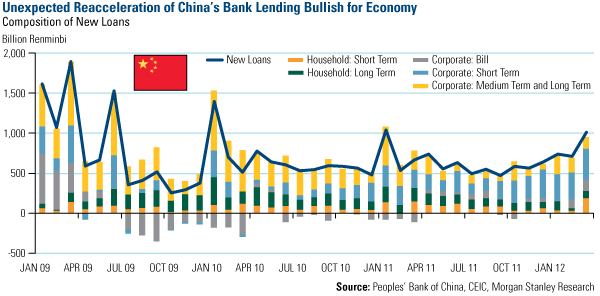Emerging Markets Radar (April 16, 2012)
Strengths
- China’s new loans were RMB 1.01 trillion in March, better than Bloomberg survey of RMB 797.5 billion and amount of new loans in February. In addition, China’s money supply (M2) grew 13.4 percent in March versus an estimate of 13 percent. By the end of March, China’s foreign reserve went up to $3.31 trillion by the end of March; indicating China had reversed the capital flight that began during the fourth quarter of last year.
- A 5.3 percent rise in inbound shipments and 8.9 percent increase in exports from a year earlier created an unexpected trade surplus of $5.35 billion for China, substantially different than the medium projection of a $3.15 billion trade deficit.
- China’s passenger car sales to dealerships rose 4.5 percent in March, exceeding the estimate of 3.9 percent. March retail sales and fixed asset investment also outpaced estimates, rising 15.2 percent and 20.9 percent, respectively.
- China’s Housing Ministry suggested a policy of withholding new home sales permits to developers unless at least 70 percent of their previous projects have been sold out, the National Business Daily says. If it becomes a policy, it should positively impact inventory and may clear the way for new projects.
- Improving electronics shipments drove a 14.6 percent rise in Philippines exports in February, beating estimates.
- South Korea’s workforce increased by 419,000 jobs in March, pushing the country’s unemployment rate down to 3.4 percent. All Asian countries have full employment.
- Turkey’s current account deficit (CAD) narrowed to $75.2 billion for the 12 months ended February 2012. The share of foreign direct investment (FDI) also strengthened.
Weaknesses
- Higher food prices pushed China’s Consumer Price Inflation (CPI) up 3.6 percent (year-over-year) in March, more than the forecast. Meanwhile, the Producer Price Index decreased in-line with expectations. Most market watchers believe China’s food prices will stabilize in the coming months.
- China’s GDP grew 8.1 percent during the first quarter, lower than market expectation of 8.3 percent. The market reacted positively to the number as many believe that it might be the bottom for China’s GDP growth this year.
- GDP growth in Russia had decelerated to 3.9 percent on a year-over-year basis in January 2012, according to Russia’s Ministry of Economic Development. This is down from the estimated 4.9 percent growth in the fourth quarter of 2011.
Opportunity
- China’s new loans were RMB 1.01 trillion in March, better than Bloomberg survey of RMB 797.5 billion and amount of new loans in February. The composition of new loans shows improvement of household long-term borrowing. These are usually mortgage loans, indicating housing market is normalizing. During a visit to Southern China, Premier Wen Jiabao reaffirmed that the government will “fine tune” its economic policy preemptively and the jump in inflation won’t change the government’s direction of monetary policy easing.













